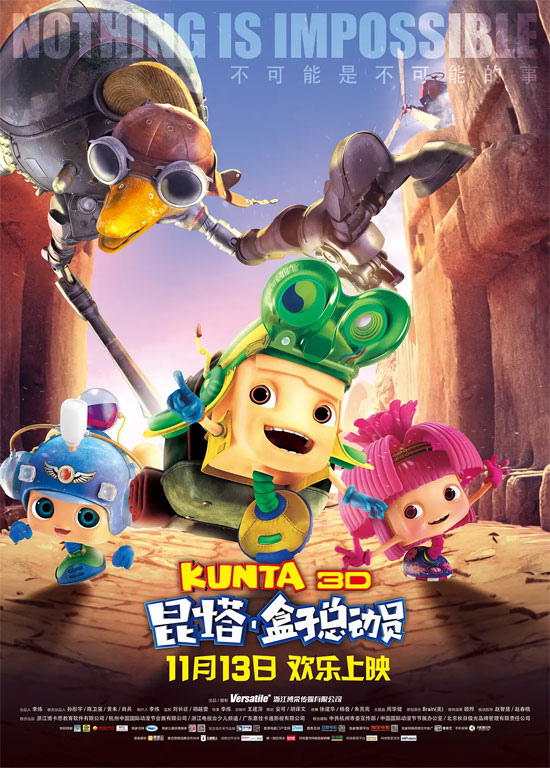Film Name: 昆塔:盒子总动员 / Kunta / Bonta

When judging people, we mainly look at their three key attributes; when judging films, we mainly look at three points: the laughs, the tears, and the cuteness. “Kunta” seems to have only the cuteness factor—the milk bubbles—that holds up, while the other two points are missing.
In fact, it should have had a profound tear-jerking moment. This emotional punch comes from the chemical reaction between the film’s mechanistic elements and its theme of “impossible things are impossible.”
The film presents a fascinating yet baffling world-building concept: the protagonists—the Boxes—exist in a transitional phase from agrarian to mechanical civilization. The presence of tribes and elders seems to interpret their level of civilization through conventional agrarian symbols. Their adversaries, however, are a purely mechanized force possessing advanced, complex mechanical technology and exhibiting strong hegemonic tendencies. Thus their conflict resembles peasants with rifles confronting airplanes and artillery, giving rise to the guerrilla fighters of Bangbang Mountain.
Films exploring mechanization inevitably grapple with a fundamental question: Can humanity truly control machines? Akira does this, Evangelion does this, Gundam does this, Transformers does this. Such themes are often depicted through balanced combat scenarios: where Unit-01 exists, so must the Angels; where Optimus Prime stands, the Decepticons follow. Rarely do we see a worldview where an agricultural civilization confronts a mechanical one with such a profound sense of imbalance.
It’s not impossible for a lower-tier civilization to overcome a higher one—Macross is a prime example—but it primarily relies on conviction and resolve. Has “Spinach” pursued “Quanta” to a point of self-forgetfulness? Has the spirit of devotion and reverence for life embodied by the word ‘Quanta’ been ingrained deep within the protagonist’s soul? This is the only force capable of restoring balance to a tilted civilizational scale. The film’s conclusion, attributing the underdog’s victory to a mere “fart,” is utterly untenable.
The ostrich plays a pivotal role. Possessing both the simple heart of an agrarian civilization and the powerful body of a mechanical one, it serves as an intermediary bridging the two civilizations. It could either be co-opted by a higher-level civilization or be transformed by a lower-level one, becoming a weapon guided by its spiritual force. This is often where the emotional core lies.
Originally an observer, this ostrich had no obligation to join the protagonist in seeking Kunta, nor to become entangled in this life-or-death struggle. Its eventual involvement stemmed entirely from the bond formed with the protagonist—a bond transcending species. This alone is deeply moving. Yet regrettably, it ultimately did not sacrifice itself—failing to follow in Kunta’s footsteps by giving its life to protect something vital. This reduces such a significant character, one with immense tear-jerking potential, to a mere dispensable prop.
Had it sacrificed itself—crushed to pieces by the Mechanical Tyrant while shielding Spinach and the others— it would have ignited the hero’s spirit within the protagonist. Through a desperate, soul-shaking cry, the chip embedded within the ostrich would have been activated, unlocking the phrase “Impossible is nothing.” The ostrich would have risen from the dead, becoming the true phoenix in the eyes of the Stick Mountain guerrillas. using the material power born of great spiritual strength to defeat the mechanical overlord (not a fart). How compelling that climax would be! So in this ostrich, I deeply felt that sense of disappointment—pouring immense expectations into something that ultimately failed to deliver.
In truth, the Box itself seems like a simple machine. Some claim its one-legged hop copies Pixar’s Lamp, but I find that accusation entirely baseless. Lamp is an anthropomorphized object, while Spinach and his kind are living beings—albeit with only one leg. Does that mean every single-legged character from now on is ripping off Lamp?
Another character in the film has two legs: the Great King of Stick Mountain. This raises another world-building question for viewers: Is this person from the Peanut Planet? Why isn’t he box-shaped? Is there a story behind this? Moreover, he’s clearly a devout believer, possessing a collection of portraits worshiping mythical beasts.
If only one-footed boxes exist, then a single foot is merely a tool. But if one-footed box people coexist with two-footed others, contrast becomes inevitable. When Spinach, a one-footed being, first encounters a two-footed person, wouldn’t he feel utterly bewildered? When everything he once took for granted is overturned, wouldn’t he question or doubt himself? If he eventually comes to understand—that for the little box people, though each has only one foot, when everyone unites and works together wholeheartedly, they possess countless feet and immense strength—this realization could lead to a powerful, weighty speech. If this small detail were woven into the final battle, it would beautifully elevate the film’s central theme.
Please specify:Anime Phone Cases » Kunta 2013 Film Review: The power of a fart?